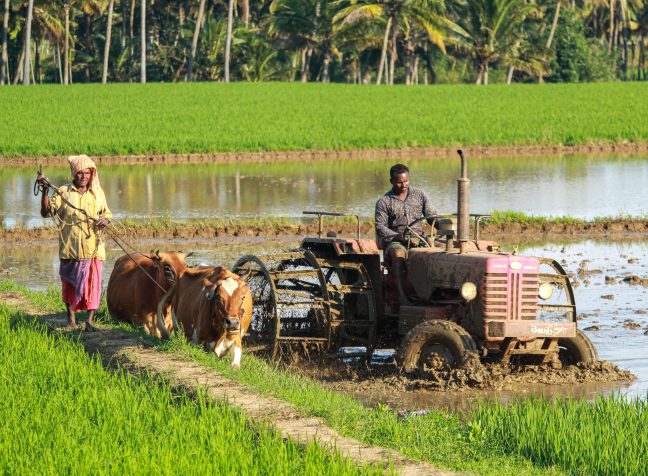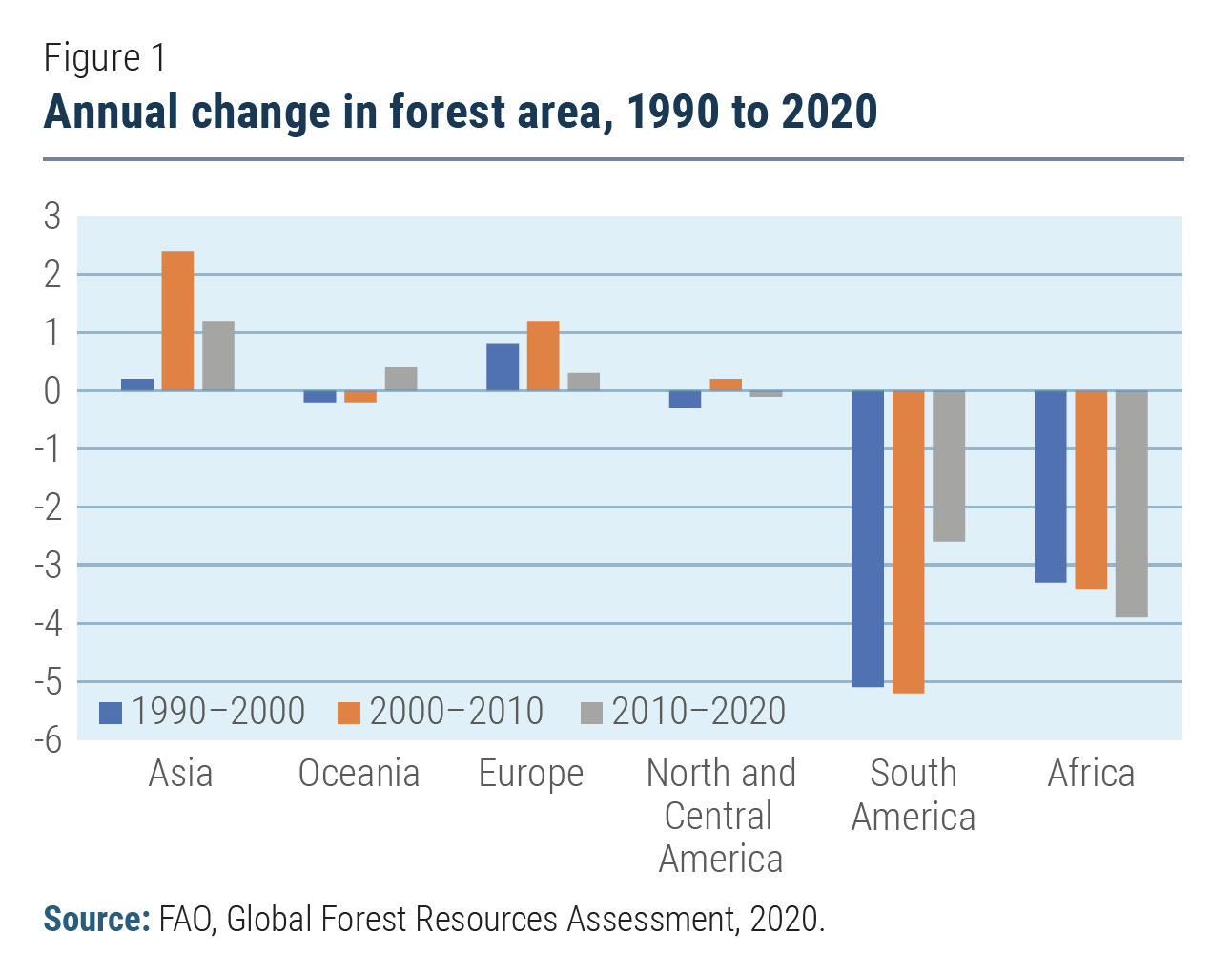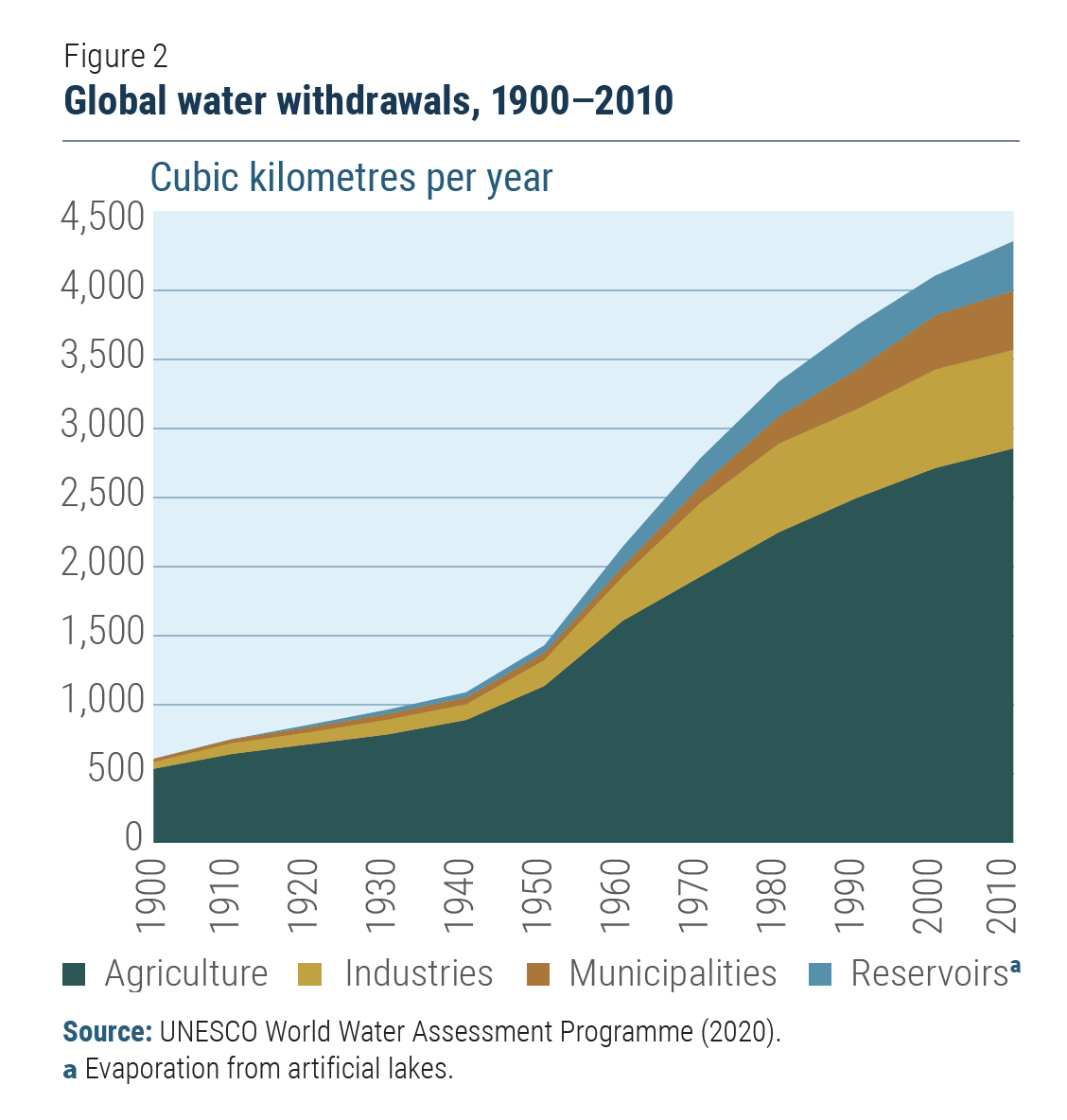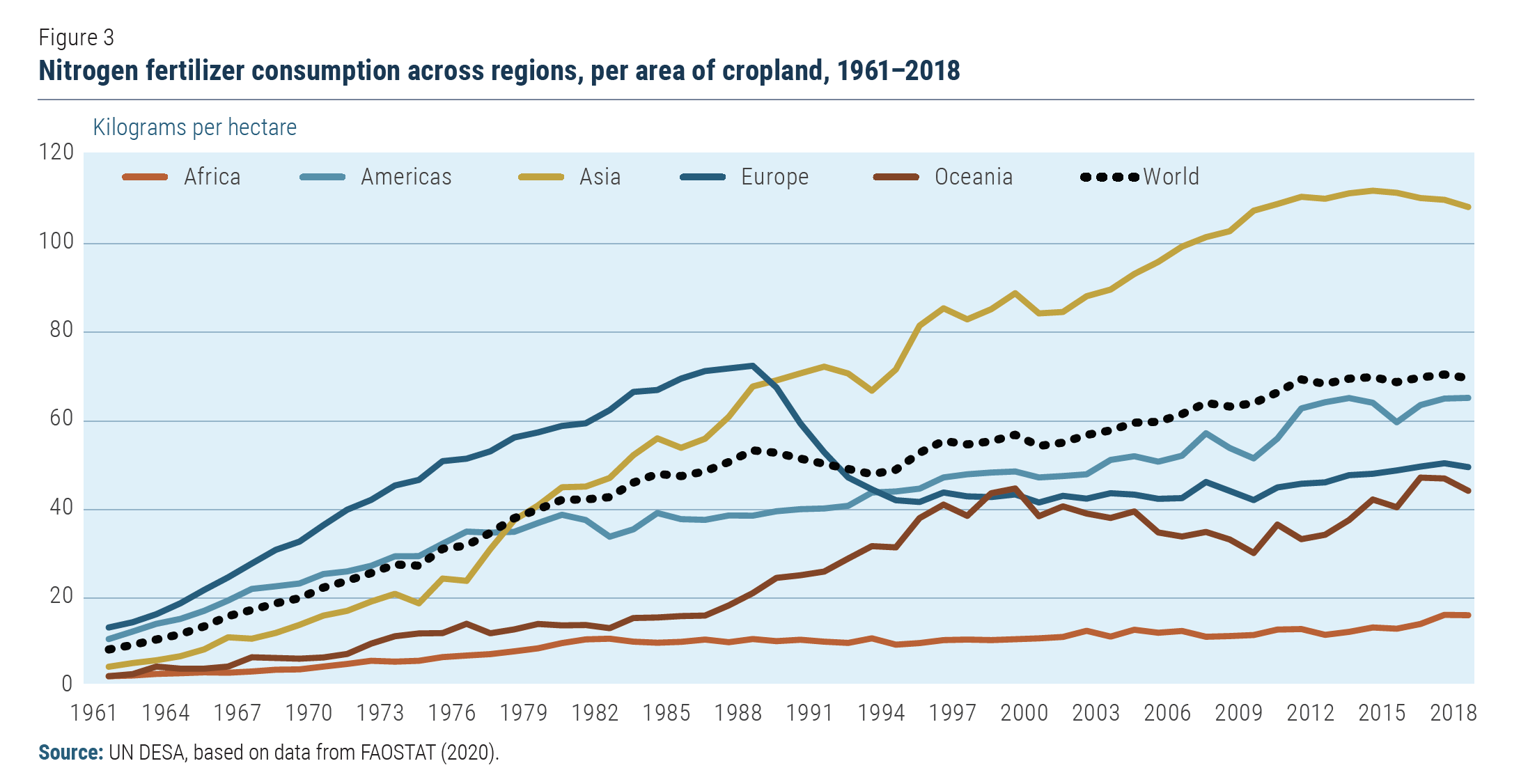
UN/DESA Policy Brief #105: Circular agriculture for sustainable rural development
 The environmental impact of conventional agriculture
The environmental impact of conventional agriculture
The huge increase in global food production in recent decades has come at a high cost for the environment. Half of the habitable land is now used for agriculture. As a result of the rapid growth in agricultural production, one third of the global forest cover has been lost in the last century and 20 per cent of the standing forest has been degraded between 1990 and 2015. Figure 1 shows the annual net change in forest area in different regions between 1990 and 2020. The figure shows that the annual rate of decline in forest area has been particularly pronounced in South America and Africa in this period. A direct consequence of deforestation is the loss of biodiversity. The conversion of natural habitats to agricultural land has contributed 60–70 per cent of total biodiversity loss experienced in this period.
The use of global freshwater resources has grown nearly sixfold over the last century, more than twice the rate of the population growth during the same period (see Figure 2). Agriculture accounts for about 70 per cent of global freshwater withdrawals. This ratio is highest in South Asia, reaching 90 per cent. Many Middle Eastern, Northern African and South Asian countries have high levels of water stress due to resource-intensive water consumption patterns. Countries like India, Iran, Libya, Pakistan, Saudi Arabia and United Arab Emirates, for example, are overextracting from existing surface or groundwater resources.
 The growth of agriculture has also been driven by more intensive use of chemical fertilizers and synthetic pesticides, which over time has eroded the quality of land for cultivation. The global use of chemical fertilizers increased from about 12 million tons in 1961 to more than 110 million tons in 2018. Fertilizer use per hectare has increased throughout the developing regions, with the largest growth in Asia, led by China and India (see Figure 3). This stands in strong contrast to sub-Saharan Africa, where the use of fertilizers remains low, increasing from 11 kg per hectare of cropland in 2000 to 16 kg per hectare in 2018.
The growth of agriculture has also been driven by more intensive use of chemical fertilizers and synthetic pesticides, which over time has eroded the quality of land for cultivation. The global use of chemical fertilizers increased from about 12 million tons in 1961 to more than 110 million tons in 2018. Fertilizer use per hectare has increased throughout the developing regions, with the largest growth in Asia, led by China and India (see Figure 3). This stands in strong contrast to sub-Saharan Africa, where the use of fertilizers remains low, increasing from 11 kg per hectare of cropland in 2000 to 16 kg per hectare in 2018.
About a quarter of the global soils is estimated to have been degraded, an area nearly the size of India and the Russian Federation, as the result of intensive agricultural practices (IPCC, 2019). For example, 12 million hectares of land in the European Union are being affected by soil erosion, reducing crop yields by 0.43 per cent at an annual loss of €1.25 billion. Chemical run-off from high volumes of fertilizers and pesticides, as well as the growing use of plastics in agriculture, have also become major sources of water pollution.
 Agricultural and land-use changes account for around 31 per cent of global greenhouse gas emissions, making the sector a major contributor to climate change. Without changes to the current unsustainable food systems and consumption patterns, food-related CO2 emissions could double by 2050, according to the IPCC.
Agricultural and land-use changes account for around 31 per cent of global greenhouse gas emissions, making the sector a major contributor to climate change. Without changes to the current unsustainable food systems and consumption patterns, food-related CO2 emissions could double by 2050, according to the IPCC.
The purpose of circular agriculture
Circular agriculture focuses on using minimal amounts of external inputs, closing nutrients loops, regenerating soils, and minimizing the impact on the environment (see Figure 4). If practiced on a wide scale, circular agriculture can reduce resource requirements and the ecological footprint of agriculture. It can also help ensure a reduction in land-use, chemical fertilizers and waste, which makes it possible to reduce global CO2 emissions. In Europe, it is estimated that a circular approach to food systems could reduce the use of chemical fertilizers by 80 per cent (Ellen MacArthur Foundation, 2016).
In a circular economy, the reuse and recycling of materials is not only a separate step to close the circle, but also an integrated part of the choices made during the production and use phase. The small arrows in Figure 4 circling back to sustainable production and sustainable use represents these processes. In circular agriculture, this can be the use of manure as organic fertilizer and the use of wastewater in irrigation.
Circular agriculture is not a new concept and was widely practiced by pre-industrial societies. However, it has been pushed aside by modern farming based on large-scale, monoculture and highly intensive practices, which are often primarily focused on maximizing profit over the protection of the environment. The business model of large-scale, specialized agricultural firms is generally not well suited for circular agriculture. The move to circular agriculture requires more emphasis on the promotion of smallholder farming, anchored in organic, mixed and agroforestry practices. Circular agriculture with more diversity of production is associated with better health and nutrition, in contrast to export-oriented monocrop production which has often led to increased food insecurity.
Circular agriculture is also more labour intensive compared to conventional farming, which offers a strategy to stimulate the economy in rural areas. The adoption of circular farming practices can thus make an important contribution to poverty reduction and food security and create new employment opportunities, particularly for rural women. Women make up 48 per cent of agricultural employment in low-income countries, according to FAO, but face greater constraints than men in accessing productive resources and services, technology, market information and financial assets. While conventional farming often requires significant capital to purchase expensive seeds, fertilizers, and pesticides, the adoption of circular agricultural practices can lower the barriers for women to enter this sector as it requires less inputs.
Circular agricultural practices
In circular agriculture, all steps of the food system from growing, harvesting, packing, processing, transporting, marketing, consuming and disposing food are designed with a view to promoting sustainable development. The integration of mixed crop-livestock and organic farming, agroforestry and water recycling and wastewater reuse, is a key element of a circular agriculture model that aims to reduce CO2 emissions, use natural resources more efficiently, and cut the use of inputs significantly.
Mixed farming
Circular agriculture is closely connected with the concept of mixed crop-livestock farming. Mixed farming, for example, may imply a switch away from mono-crop agriculture to growing a set of interdependent crops where the cultivation of one creates favourable conditions for others on the same land. Crop diversity becomes an effective practice to reduce inputs, manage soil fertility, and enhance resilience, and the combined production of different crops and legumes can raise yields in a sustainable way. Mixed farming that combines crop cultivation with animal husbandry offers additional opportunities to deepen circular agriculture. Use of locally produced feed and manure instead of imports and chemical fertilizers, for example, can contribute to reduced CO2 emissions of agriculture. The objective is to capitalize on the synergy that exists between crops and livestock to create a circular food system, as illustrated in Figure 5.
Mixed-farming practices, despite the many benefits, have increasingly been replaced by highly specialized agricultural systems. In Europe, the Common Agricultural Policy has encouraged farmers to enlarge and specialize their agricultural production. Studies of European agriculture, however, have demonstrated the potential environmental and economic advantages of mixed croplivestock farming over such specialized systems (Ryschawy and others, 2012). Mixed crop-livestock farms have lower costs, are less sensitive to market and price fluctuations and result in lower levels of nitrogen pollution. While the context matters—and there is variability within mixed-farming systems—such approaches can ensure more sustainable agricultural and rural development.
Organic agriculture
Organic farming is another key element of circular agriculture, striving to eliminate the dependence on chemical fertilizers, pesticides and plastics. Organic farming is also typically more labour intensive, thereby providing rural employment and development opportunities. Reduced use of pesticides and fertilizer also has gender implications. In many parts of the world, handling of pesticides is considered a male task, so pesticide-free organic farming can promote women’s participation in agriculture (Meemken and Qaim, 2018).
Yields in conventional agriculture have been historically higher than in organic farming, but this differential has decreased in recent years. (Robertson and others, 2004). Under certain conditions and management practices and for crop groups such as rice, soybean, corn and grass-clover, organic farming has come close to matching conventional agricultural systems in terms of yields and land requirements (Reganold and Wachter, 2016). Techniques such as rotational farming, cover cropping, multi- cropping, and polyculture in organic systems further reduce the yield and land-use difference (Ponisio and others, 2015).
A total of 72.3 million hectares were organically managed in 2019, compared with 11 million hectares in 1999. Despite rapid growth, there are still many obstacles to more widespread adoption of organic farming from vested interests and existing policies; lack of information and knowledge; weak infrastructure; as well as misconceptions and cultural biases. Organic farming has also been subject to less public and private research and investment than conventional agricultural practices, especially in developing countries.
Some countries, nonetheless, have already set ambitious goals for developing organic agriculture. Bhutan has set the goal of becoming the world’s first 100 per cent organic nation. Sikkim, a state in north-eastern India managed to go 100 per cent organic in 2016 by phasing out chemical fertilizers and pesticides, as well as banning the sale and use of chemical pesticides. In 2010, Denmark adopted an action plan to encourage organic farming and consumption and the country now has the highest market share of such products in the world at 10 per cent, with almost 80 per cent of Danes purchasing organic food.
Agroforestry

Agroforestry, defined as tree planting in combination with crops or pastures, is an integral part of circular agriculture. Tree planting can help restore biodiversity in agricultural landscapes, while increasing soil fertility by enhancing the accumulation of organic matter from decaying nature. Agroforestry can also make agriculture more circular by reducing the dependency on chemical fertilizers and pesticides. As agroforestry reduces the need for inputs, it is more accessible for female farmers who often have less financial resources and limited access to credit, which can provide new opportunities for women’s empowerment in the rural economy. In addition, the collection of firewood and fodder is primarily the task of women in rural areas around the world. Agroforestry makes these products available on the farm and thus reduces the time spent by women on such activities, which can contribute to their empowerment.
Combining agroforestry with livestock farming offers opportunities for the application of circular agriculture with lower ecological impacts. Many smallholder farmers raise livestock, and they often use crop residue biomass as animal fodder, which reduces the available soil cover. However, with trees growing on their farms, there is more available biomass to meet livestock needs and maintain constant soil cover. Agroforestry can also reduce the need for plastic mulch by making the use of leaves and other plants as organic matter.
From an economic perspective, agroforestry can ensure more diversified products and more reliable income stream for farmers. In Zambia, farming systems that integrate trees with maize crops have higher average yields and returns than those which use chemical fertilizer (FAO, 2016). Similarly, in the drylands of West Africa, farmers in Burkina Faso, Ghana, Niger and Senegal, have regenerated tree growth and diversified production as part of agroforestry initiatives (Reu, Tappan and Smale, 2009). The recent experience of Kenya in strengthening agroforestry to combat climate change is briefly discussed in the case study below.
There are policy and technological obstacles to the adoption of agroforestry despite many benefits. The issue of land tenure is central to realizing the potential of agroforestry, and many initiatives have failed because farmers had limited land tenure. Research has established that the likelihood of farmers investing in agroforestry increases if they have secure, long-term tenure to a sufficiently large land area. This is due to the long period required for trees to mature and start generating income (FAO and ICRAF, 2019).
Water recycling and wastewater use

The recycling and reuse of irrigation water is an important part of circular agricultural water management. The use of wastewater in agriculture could potentially irrigate an additional 40 million hectares or 15 per cent of all irrigated land. Reusing wastewater for agricultural purposes can reduce pollution, ensure more water conservation and provide additional resources for recharging aquifers. Morocco is one of the countries currently scaling-up the use of wastewater for agricultural irrigation, as discussed in the case study below. If adequately treated and safely applied, wastewater is a valuable source of both water and nutrients, contributing to food and nutrition security and the improvement of livelihoods. Livestock, for example, generate a substantial amount of wastewater, which is rich in organic matter and containing nutrients important to agriculture. Women are also more affected by the lack of sufficient wastewater treatment than men due to their greater exposure to unsafe water at the household level.
Return-flow systems where drainage and surplus irrigation are channeled back to the irrigation network are also an integral element of circular agriculture. However, water recycling plants have generally been energy intensive and produced sludge that can be difficult to discard. Newer technologies may be able to alleviate this problem by developing new sludge by-products that promote recycling at net zero energy cost by capturing biogas. Biogas, a by-product of the treatment process, can be used to offset the energy consumption of the facility. These advances offer new opportunities not just to close the water cycle but also to reduce carbon emissions, energy costs and environmental contaminants.
Policies to promote circular agriculture
The adoption of circular agriculture aims to address the rising concerns about the unsustainability of global food production, the destruction of soils, loss of biodiversity and depletion, degradation and pollution of water and land resources. The objective is to farm with nature rather than against it. The adoption of circular practices in rural areas is only viable if complemented by other changes that impact overall demand in the food system at the urban and national levels such as the reduction of food waste, changes in diets, and the willingness to pay more for organic products. A comprehensive set of policies, technologies and institutions are needed to promote the adoption of circular agricultural practices in rural areas, including the following:
Invest in technologies and research for circular agriculture
A shift to circular agriculture should not be seen as a return to past practices, but rather as a way to farm with nature, while actively making use of scientific advances, innovations, and new technologies. Public policies that place high value on achieving sustainable use of natural resources can encourage smallholder farmers to adopt new technologies in areas such as drip irrigation, precision agriculture, rainwater harvesting and crop productivity. It is also important to develop new technologies to close the water cycle and move towards water recycling at net zero energy cost. Agricultural research can also focus on enabling smallholder farmers to adopt such technologies as well as closing the yield gap between organic and conventional farming.
Strengthen institutions and incentives to foster circular agriculture
Institutions and incentives such as water user associations and secure water and land tenure rights are critical for encouraging smallholder farmers to adopt circular agricultural practices. This includes women having adequate access to agricultural land through secure tenure rights.
Existing policies could also be reviewed with a view to eliminating those subsidies in agriculture, energy, and transportation, which undermine the sustainable use of natural resources. Subsidies that incentivize the overuse of water, energy and fertilizers could also be phased-out or eliminated, with the savings invested in agricultural research, improved water and land-use management, compensatory income support to small farmers, and targeted smart subsidies to achieve specific circular agricultural practices. Subsidies could for example be paid on the condition that farmers adopt an easily verifiable organic soil fertility management practice, which sequester significant amount of carbon.
Enhance international cooperation
Because of the significant impact of agriculture and food production on society and the environment, both nationally and globally, all countries have a common stake in the application of the circularity principle in this sector. Smallholder farmers need improved access to new technologies and skills, which can be facilitated through international cooperation for technology transfer and capacity development. International cooperation can also foster circular agriculture by setting common norms and standards for waste management and reduction, sustainable procurement practices, agricultural value chains, and reporting on food loss and waste. Many developing countries also need international support for large-scale infrastructure investment. Given the growing importance of fostering sustainable value chains in food systems, global cooperation is necessary to avoid a race to the bottom in terms of environmental safeguards and standards. The COVID-19 pandemic has also prompted countries to consider shorter and more local value chains of essential goods and services, particularly when it comes to agricultural crop production, thus triggering the enhanced need for international cooperation to upgrade technological, financing and marketing skills and other extension services.



Follow Us